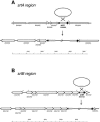Importance of srtA and srtB for growth of Bacillus anthracis in macrophages
- PMID: 16041044
- PMCID: PMC1201184
- DOI: 10.1128/IAI.73.8.5222-5228.2005
Importance of srtA and srtB for growth of Bacillus anthracis in macrophages
Abstract
We examined the effect of mutation of two sortase genes of Bacillus anthracis, srtA and srtB, on the ability of the bacterium to grow in J774A.1 cells, a mouse macrophage-like cell line. While disruption of either srtA or srtB had no effect on the ability of the bacteria to grow in rich culture media, mutations in each of these genes dramatically attenuated growth of the bacterium in J774A.1 cells. Complementation of the mutation restored the ability of bacteria to grow in the cells. Since the initial events in inhalation anthrax are believed to be uptake of B. anthracis spores by alveolar macrophages followed by germination of the spores and growth of the bacteria within the macrophages, these results suggest that two sortases of B. anthracis may be critical in the early stages of inhalation anthrax.
Figures




References
-
- Bierne, H., S. K. Mazmanian, M. Trost, M. G. Pucciarelli, G. Liu, P. Dehoux, L. Jansch, F. Garcia-del Portillo, O. Schneewind, and P. Cossart. 2002. Inactivation of the srtA gene in Listeria monocytogenes inhibits anchoring of surface proteins and affects virulence. Mol. Microbiol. 43:869-881. - PubMed
-
- Cataldi, A., E. Labruyere, and M. Mock. 1990. Construction and characterization of a protective antigen-deficient Bacillus anthracis strain. Mol. Microbiol. 4:1111-1117. - PubMed
-
- Cendrowski, S., W. MacArthur, and P. C. Hanna. 2004. Bacillus anthracis requires siderophore biosynthesis for growth in macrophages and mouse virulence. Mol. Microbiol. 51:407-417. - PubMed
-
- Dixon, T. C., A. A. Fadl, T. M. Koehler, J. A. Swanson, and P. C. Hanna. 2000. Early Bacillus anthracis-macrophage interactions: intracellular survival and escape. Cell. Microbiol. 2:453-463. - PubMed
MeSH terms
Substances
LinkOut - more resources
Full Text Sources
Other Literature Sources
Medical

